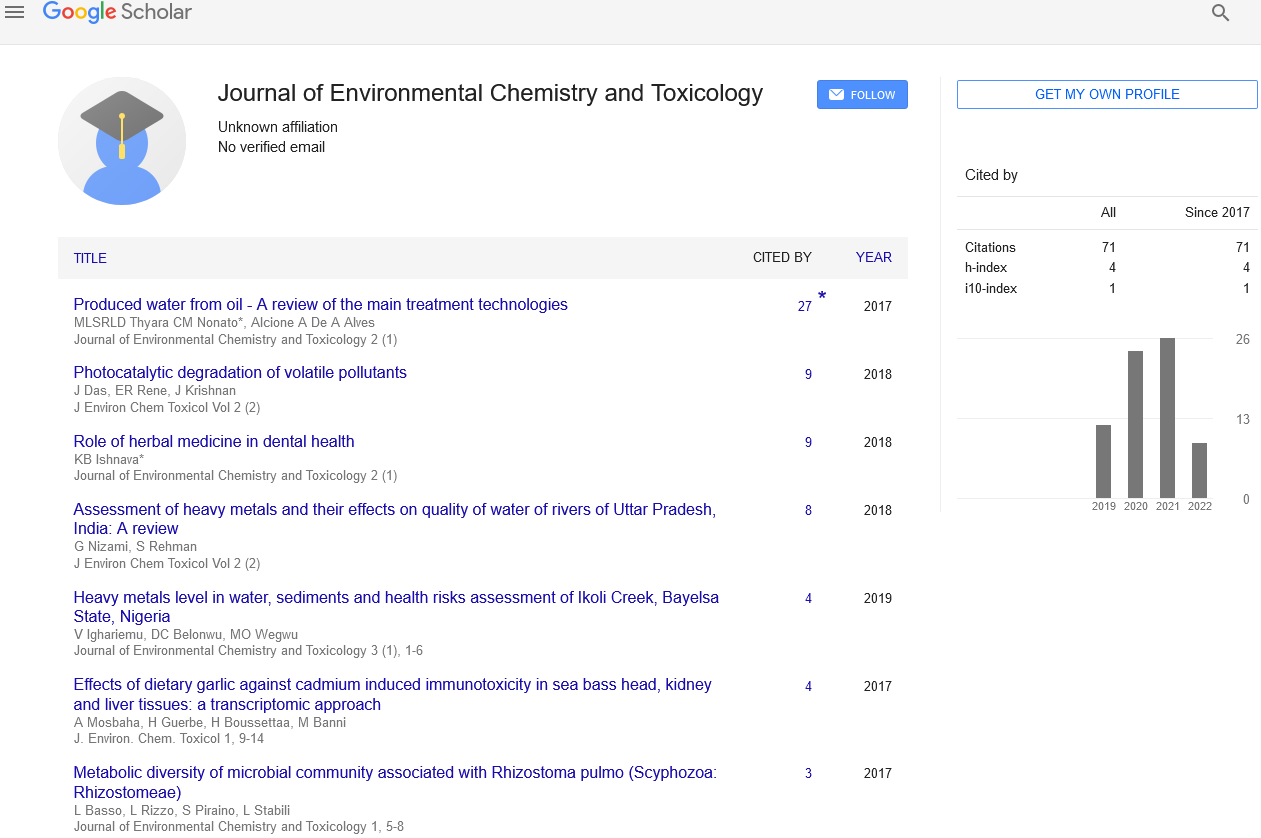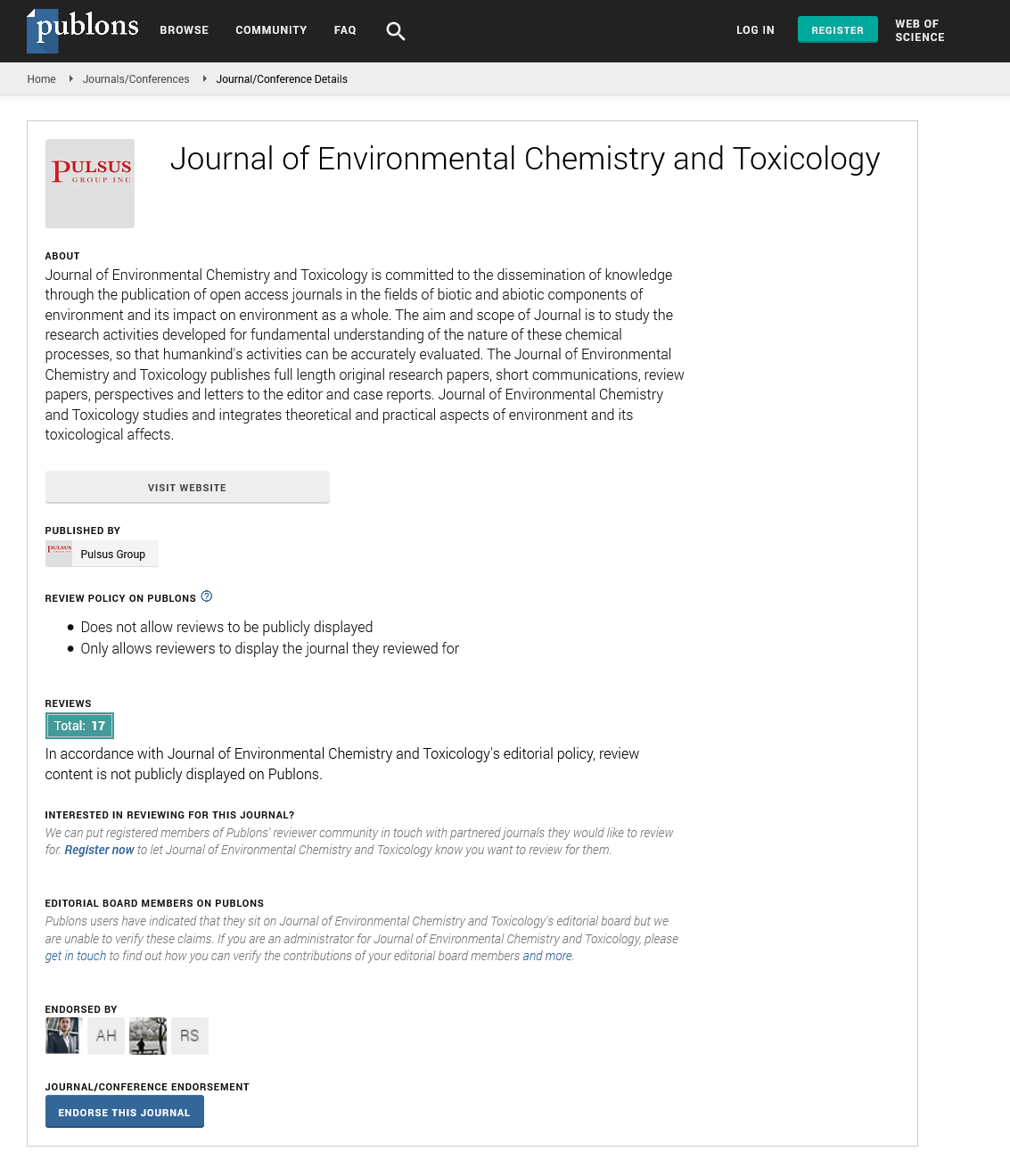Arsenic: Cellular physiology of biomolecular condensates
Received: 04-Jul-2022, Manuscript No. PULJECT-22-5203; Editor assigned: 12-Jul-2022, Pre QC No. PULJECT-22-5203(PQ); Accepted Date: Jul 15, 2022; Reviewed: 14-Jul-2022 QC No. PULJECT-22-5203(Q); Revised: 16-Jul-2022, Manuscript No. PULJECT-22-5203(R); Published: 24-Jul-2022, DOI: 10.37532/pulject.2022.6(4);01
Citation: Stewart J. Arsenic: Cellular physiology of biomolecular condensates. J Environ Chem Toxicol. 2022;6(4):01.
This open-access article is distributed under the terms of the Creative Commons Attribution Non-Commercial License (CC BY-NC) (http://creativecommons.org/licenses/by-nc/4.0/), which permits reuse, distribution and reproduction of the article, provided that the original work is properly cited and the reuse is restricted to noncommercial purposes. For commercial reuse, contact reprints@pulsus.com
Abstract
For a reasonably long period, it has been recognized that cells can contain organelles without membranes. Stress granules, processing bodies, and PML-NBs have all undergone extensive arsenic-related research among the membrane-less organelles. Recently, it has been demonstrated that the membrane-less organelles that concentrate biomolecules (proteins, nucleic acids) can self-organize through phase separation/transition. These biomolecular condensates (membrane-less organelles) can boost a particular reaction’s efficiency locally. Since the membrane-dependent certain compartmentalization has long been known to explain highly ordered biochemical complexes in cells, the biomolecular condensates have garnered enormous attention. In this brief review, we focus on how phase separation begins in each biomolecular condensate that arsenic may be present. We consider the suitability of the biomolecular condensates are formed at ROS levels that rely on the presence of arsenic. These viewpoints inspired us to reexamine the biophysical and bio rheological effects of arsenic on biological processes. Some biomolecules, such as proteins and RNA, are greatly concentrated in liquid droplet-like forms that are not encircled by a lipid bilayer membrane during Liquid-Liquid Phase Separation (LLPS), a physiological biological process.
Keywords
Bimolecular condensates
Introduction
Biomolecular condensates are these droplet-like cellular formations such bodies, granules, and speckles. In reaction to modifications in the intracellular environment, they are either generated in the cytoplasm or nucleus. Water and solutes can flow more easily since each bimolecular condensate’s interface lacks a membrane. As a result, fluid aggregates and bimolecular condensates can be differentiated from one another. When the cell is subjected to a sustained super saturation of biomolecules, the aggregates may develop permanently. Characteristics of interactions between the weak, multivalent, and dynamic proteins and biopolymers needed to generate bimolecular condensates include halted mRNA during stress granule formation. Intrinsically Disordered Regions (IDRs), repetitive modular domains, oligomerization domains, and/or substrate-binding (like RNA-binding) domains are some of the protein features that aid in the production of biomolecular condensates. IDRs are regions that are frequently anticipated by computation to not form fixed 3-D structures but rather to be conformationally diverse, allowing them to interact with partner molecules in dynamic, flexible multivalent interactions. The valence and patterning of a variety of amino acid side chain interactions, such as or cation, inside IDRs, contribute to LLPS in cells. Combining proteins resulting in the creation of liquid droplets, each of which has a distinct sort of repetitive modular domains. Li et al. employed two proteins, one of which has a proline-rich motif and the other of which has a tandemly organized Src homology 3 domain. The discovery strengthened the notion that higher valence encourages LLPS. If one only takes the research of mutant mice into consideration, the requirement of biomolecular condensates in cells is puzzling. For instance, coilin (Cajal body resident) knockout mice exhibit reduced fecundity and are semi-lethal, yet plants with homozygous coilin gene mutations or flies with coilin null mutants are totally viable Neat noncoding RNA (Paraspeckle resident) is another illustration; Neat1/ mice are healthy. Additionally, Promyelocytic Normally Developing Leukemia-Nuclear Bodies (PML-NBs) knockout mice. However, by improving the kinetics and specificities of reactions locally or by restricting reactions through the temporal confinement of biomolecules, biomolecular condensates may help a variety of biological activities. According to explicit data, arsenic is both a multi-organ carcinogen (IPCS, 2001), a chemotherapeutic treatment for some malignancies, including Acute Promyelocytic Leukemia (APL), and a risk factor for cancers, among others. Arsenite (As3+) has a strong affinity for thiol groups, which led to the idea that binding to cysteine residues is the first step in a number of arsenic-induced toxicological and pharmacological activities. Studies investigating Promyelocytic Leukemia (PML) protein, a scaffold protein of PML-NBs, as a target for Arsenic Trioxide (As2O3 ) as a chemotherapeutic drug for the treatment of APL, have shown that this reaction is notably triggered by arsenite. Today, it is understood that PML-NBs are one of the biomolecular condensates produced by LLPS. We examine the role of arsenic in the production of biomolecular condensates, using stress granules and PML-NBs as examples, since arsenic’s role in the LLPS has not been thoroughly reported.
Discussion
Arsenite induces the formation of strain granules at a totally high, a few masses of µM, attention. As with inside the case of strain granule induction, fairly decrease attention of arsenite produces ROS, and hence can as a minimum in element circuitously make contributions to the ROS-brought on disulfides that crosslink PML protein. Some warning need to be paid to this concept due to the fact theoretically upon publicity to immoderate oxidants, vital protein this may be oxidized to transiently shape Protein Sulfenic Acid (PSOH) or Protein Sulfinic Acid (PSO2 H), or be completely oxidized into Protein Sulfonic Acid (PSO3 H) (i.e., inhibitory to oligomerization). In this scenario, arsenite probably serves as a reductant towards Protein Sulfenic Acid (PSOH), reverting the protein to the thiol shape. Oligomerization contributes to the multivalence of the complex, thereby lowering solubility and selling LLPS. Immunoblot evaluation confirmed that maximum PML protein is detected withinside the detergent-soluble fraction, while in cells uncovered to 0.1 µM –1 µM arsenite for 1hour –2 hour, nearly all PML protein is detected with inside the detergent-insoluble fraction, which corresponds to the fraction related to the nuclear matrix. Examination of CHO cells stably transfected with an antioxidant responsive detail established that promotor activation calls for 1 µM arsenite (with 6h arsenite publicity), or calls for as a minimum 2h (with three µM arsenite publicity). Both are above the specified tiers for insolubilization (i.e., 0.1 µM –1 µM arsenite for 1–2 h), suggesting that arsenite-structured solubility adjustments of PML protein can arise underneath the extent of oxidative strain induction (Hirano et al., 2013). For the instance of attention range, the plasma arsenic degree in APL sufferers treated: 0.5 µM; the provisional WHO guiding principle fee of arsenic.






